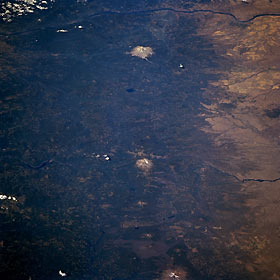
Save this image free of charge
in 800 pixels for layout use
(right click, Save as...)
|
|
Ref : T02107
Theme :
Looking at Earth - Volcanos (181 images)
Title : Cascade Range, Oregon, U.S.A. October 1994
Caption :
This spectacular low-oblique, north-looking photograph features the Cascade Range of northern Oregon from North Sister Volcano at the bottom center to Mount Hood at the top center. Along the top portion of the photograph, the Columbia River is visible traversing east to west through the gorge it has cut. The Pacific Ocean shoreline was formed along the western edge of the mountain range, which began forming approximately 65 million years ago as rising magma boiled to the surface and built layer upon layer. Roughly 17 million years ago, the Cascade volcanoes became increasingly active, opening numerous fissures and pouring out lava. Approximately 2 million years later, dozens of the volcanoes erupted simultaneously, building the mountains in the Cascade Range to their present heights. Stratovolcanoes like Mount Hood, Mount Jefferson (the snow-covered peak near the center of the image), and North Sister are visible with less discernible shield volcanoes like Mount Washington and Three Fingered Jack located between North Sister and Mount Jefferson. Lava flows north of North Sister, mostly from Belknap Crater, a new, inactive, shield volcano, encompass areas around McKenzie Pass. Discernible east of Mount Jefferson (center right) are the Metolius River and Lake Chinook and west (left center) are the North Santiam River and Detroit Reservoir.
|
|

